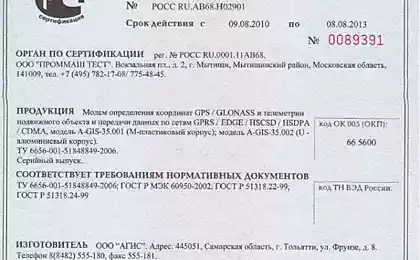1096
Monitoring of transport: CIS vs West
In this article I will try to grasp the immensity, namely: Compare monitoring transport markets in Russia and in the West and carry the analogy between them.
This article does not pretend to the presentation of material in full to bringing the specific numbers of volumes of the market: it is bounded trends that are currently visible.
To begin to address the sources suggest - where to begin monitoring traffic. And he begins, as everyone guessed the west. When the cost of mobile phone fell from dizzying heights (mid 90s), the mobile electronics industry began to look for new markets. But a new market in the form of vehicle tracking will not appear immediately because was important to monitor the accuracy of the positioning. Namely positioning position with minimum error for civilian purposes was impossible, because the GPS was originally designed as a purely military project for precision-guided missiles at fixed, and then on the moving objects in the air and on the ground. And only in 2000. coarsening accuracy canceled his decree President Bill Clinton. It was in 2000 can be considered a starting point in the development of transport monitoring.
In the early 2000s began to appear the first device that can be installed on trucks and produce tracking. A little later, the devices began to deliver in Russia. The second problem, which stood in the way of large-scale use of vehicle monitoring - is the coverage area of cellular networks GPRS. That is why the first car terminal to transmit the coordinates in an SMS message. A software manager could watch "a point on the map," which shows the location of the vehicle.
But since then, much time has passed, and the monitoring system of transport in Russia and in the West stepped far forward, choosing their path of development. Maybe something even copying each other. Let us consider in more detail these markets now. Depth of penetration in the markets of Russia and the West, we will compare the availability of commercial services in these two markets.
Major players
Commercial services are developing a large number of companies. How these companies are popular, can indirectly judge by the number of vehicles connected to their software platform. In the West, in the news recently voiced their data Octo Telematics заявив about 3 million connected subscribers, and TomTom Telematics about 400,000 . Also notable players in the international market are MiX Telematics, DigiCore, Navman Wireless, Omnitracs, Teletrac, Telogis, Trimble, Webtech Wireless, Altea, ATX Group, Connexis, Eurowatch, Verizon Telematics, WirelessCar, Trafficmaster, Masternaut, Garmin, CIS figures with six zeros until no one to brag, but there is a company with a clear leadership position, such as Gurtam with the connected 500,000 vehicles. Recently, the company SpaceTeam announced 40,000 users connected to the telematics platform. Also, the most notable players in the Russian market are Tekhnokom (trademark Autograph) APKKOM, Galileo, Scout, Omnicomm, SantelNavigatsiya, Fort Telecom, Sibsvyaz, Antor, Statt, Advantum, Escort, Incotex, Barcode, Athol, CSBI, ENDS. And now proceed directly to the commercial services. In order not to get lost in a large variety of services, monitoring, let them be divided into systems that are equipped with the "assembly line", or as they say in the west, OEM, and aftermarket (Aftermarket). Also highlight areas of M2M services for private vehicles and the monitoring of commercial vehicles.
eCall vs ERA GLONASS
System of emergency response are intended for promptly informing the emergency services about traffic accidents. The essence of the project lies in the M2M-modules that are installed in the car on the conveyor system and allow the accident to determine the exact coordinates and, if necessary, send the information via cellular connection to the emergency services. Currently implemented pilot implementation project in the framework of the HeERO (Harmonised eCall European Pilot Project - a project on the harmonization of the European project eCall), in восьми EU value of 10 million euros, the Czech Republic, Finland, Germany, Greece, Italy, the Netherlands, Romania and Sweden. On the Russian ERA GLONASS already spent 3 5 -4000000000 rubles, but the list of regions where you can see the system in action, has not yet announced.
Equipping vehicles eCall system and ERA GLONASS originally anticipated on the conveyor. In the west, many automakers have already started production of cars with support eCall: BMW, Mercedes-Benz, PSA Peugeot Citroën, Volvo Cars. In Russia before the conveyor is not reached, but the media already has information that will be completed with Lada Vesta ERA GLONASS system. ERA GLONASS system also interested in MAN.
But to call the emergency response system of commercial services is probably not quite right, so the Western automakers began to offer their additional services that have received the general name of «Connected Car». The connected car «Connected Car» can be attributed to the M2M services for private vehicles.
Connected Car
I've been thinking, what additional M2M service currently offered by Russian automakers, but to find a name and could not. In this direction, the lag is felt that it is not known when and by whom is full. But the lack of M2M services "from the automaker's" can solve the secondary market.
In the West radically different picture: on the contrary, it is difficult to find a car manufacturer who has not started working with IT companies to establish joint M2M solutions. And there are many examples.
Volkswagen Car-Net telematics services demo video:
Audi Connect telematics service and video instruction:
Toyota T-Connect telematics services:
Volvo On Call telematics service):
Who watched videos, certainly understood the opportunities that can provide M2M services in the car. If you believe the forecasts of analysts (for the Western market), we can assume that the "not connected car" soon may not stay at all.

In general, about the segment of private vehicles written enough to assess the overall situation. Well, next time I'll tell you how the development of M2M services for commercial vehicles and trucks, and share their observations about the services that are offered on the secondary market.
Source: habrahabr.ru/post/241109/
This article does not pretend to the presentation of material in full to bringing the specific numbers of volumes of the market: it is bounded trends that are currently visible.
To begin to address the sources suggest - where to begin monitoring traffic. And he begins, as everyone guessed the west. When the cost of mobile phone fell from dizzying heights (mid 90s), the mobile electronics industry began to look for new markets. But a new market in the form of vehicle tracking will not appear immediately because was important to monitor the accuracy of the positioning. Namely positioning position with minimum error for civilian purposes was impossible, because the GPS was originally designed as a purely military project for precision-guided missiles at fixed, and then on the moving objects in the air and on the ground. And only in 2000. coarsening accuracy canceled his decree President Bill Clinton. It was in 2000 can be considered a starting point in the development of transport monitoring.
In the early 2000s began to appear the first device that can be installed on trucks and produce tracking. A little later, the devices began to deliver in Russia. The second problem, which stood in the way of large-scale use of vehicle monitoring - is the coverage area of cellular networks GPRS. That is why the first car terminal to transmit the coordinates in an SMS message. A software manager could watch "a point on the map," which shows the location of the vehicle.
But since then, much time has passed, and the monitoring system of transport in Russia and in the West stepped far forward, choosing their path of development. Maybe something even copying each other. Let us consider in more detail these markets now. Depth of penetration in the markets of Russia and the West, we will compare the availability of commercial services in these two markets.
Major players
Commercial services are developing a large number of companies. How these companies are popular, can indirectly judge by the number of vehicles connected to their software platform. In the West, in the news recently voiced their data Octo Telematics заявив about 3 million connected subscribers, and TomTom Telematics about 400,000 . Also notable players in the international market are MiX Telematics, DigiCore, Navman Wireless, Omnitracs, Teletrac, Telogis, Trimble, Webtech Wireless, Altea, ATX Group, Connexis, Eurowatch, Verizon Telematics, WirelessCar, Trafficmaster, Masternaut, Garmin, CIS figures with six zeros until no one to brag, but there is a company with a clear leadership position, such as Gurtam with the connected 500,000 vehicles. Recently, the company SpaceTeam announced 40,000 users connected to the telematics platform. Also, the most notable players in the Russian market are Tekhnokom (trademark Autograph) APKKOM, Galileo, Scout, Omnicomm, SantelNavigatsiya, Fort Telecom, Sibsvyaz, Antor, Statt, Advantum, Escort, Incotex, Barcode, Athol, CSBI, ENDS. And now proceed directly to the commercial services. In order not to get lost in a large variety of services, monitoring, let them be divided into systems that are equipped with the "assembly line", or as they say in the west, OEM, and aftermarket (Aftermarket). Also highlight areas of M2M services for private vehicles and the monitoring of commercial vehicles.
eCall vs ERA GLONASS
System of emergency response are intended for promptly informing the emergency services about traffic accidents. The essence of the project lies in the M2M-modules that are installed in the car on the conveyor system and allow the accident to determine the exact coordinates and, if necessary, send the information via cellular connection to the emergency services. Currently implemented pilot implementation project in the framework of the HeERO (Harmonised eCall European Pilot Project - a project on the harmonization of the European project eCall), in восьми EU value of 10 million euros, the Czech Republic, Finland, Germany, Greece, Italy, the Netherlands, Romania and Sweden. On the Russian ERA GLONASS already spent 3 5 -4000000000 rubles, but the list of regions where you can see the system in action, has not yet announced.
Equipping vehicles eCall system and ERA GLONASS originally anticipated on the conveyor. In the west, many automakers have already started production of cars with support eCall: BMW, Mercedes-Benz, PSA Peugeot Citroën, Volvo Cars. In Russia before the conveyor is not reached, but the media already has information that will be completed with Lada Vesta ERA GLONASS system. ERA GLONASS system also interested in MAN.
But to call the emergency response system of commercial services is probably not quite right, so the Western automakers began to offer their additional services that have received the general name of «Connected Car». The connected car «Connected Car» can be attributed to the M2M services for private vehicles.
Connected Car
I've been thinking, what additional M2M service currently offered by Russian automakers, but to find a name and could not. In this direction, the lag is felt that it is not known when and by whom is full. But the lack of M2M services "from the automaker's" can solve the secondary market.
In the West radically different picture: on the contrary, it is difficult to find a car manufacturer who has not started working with IT companies to establish joint M2M solutions. And there are many examples.
Volkswagen Car-Net telematics services demo video:
Audi Connect telematics service and video instruction:
Toyota T-Connect telematics services:
Volvo On Call telematics service):
Who watched videos, certainly understood the opportunities that can provide M2M services in the car. If you believe the forecasts of analysts (for the Western market), we can assume that the "not connected car" soon may not stay at all.

In general, about the segment of private vehicles written enough to assess the overall situation. Well, next time I'll tell you how the development of M2M services for commercial vehicles and trucks, and share their observations about the services that are offered on the secondary market.
Source: habrahabr.ru/post/241109/






















